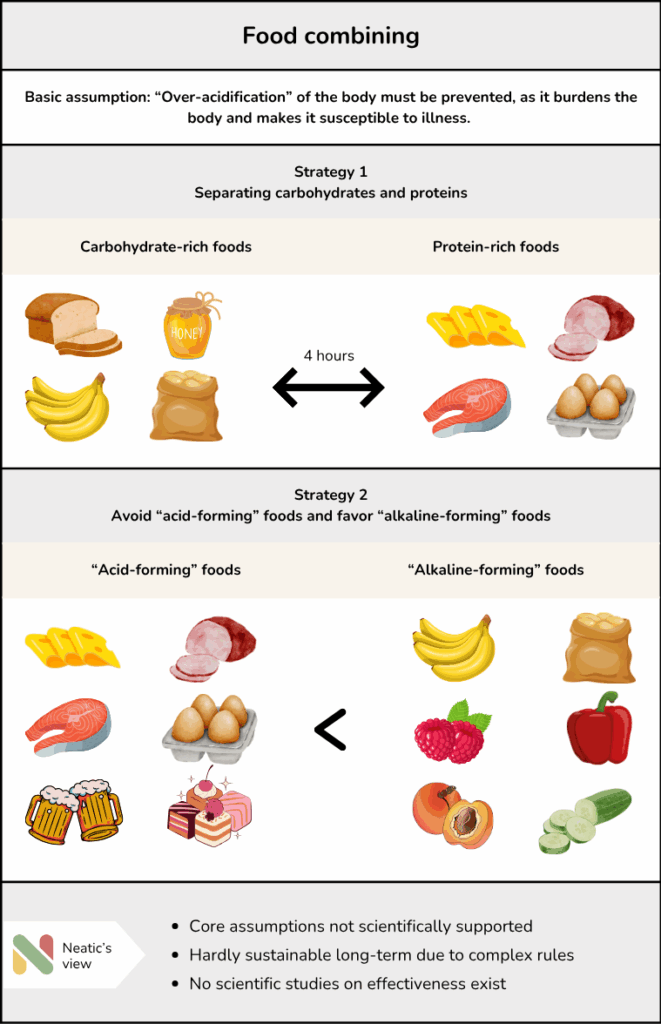
Major points:
- Food combining aims to protect the body from an allegedly harmful “over-acidification” by separating carbohydrates and proteins and by avoiding “acid-forming” foods while favoring “alkaline-forming” foods.
- Some dietary recommendations, such as eating fruits and vegetables (considered “alkaline-forming”) and avoiding ultra-processed foods (considered “acid-forming”), are reasonable.
- However, the core assumptions of food combining are not scientifically supported, and no studies confirm its effectiveness.
Who developed food combining?
Food combining was introduced in the 1920s by the American physician William Howard Hay (1866–1940). According to his own accounts, he cured himself of a severe kidney disease through dietary changes, which inspired him to develop this concept further.
What is the core assumption?
The fundamental idea behind food combining is that “over-acidification” burdens the body and makes it more susceptible to diseases. To maintain health and well-being, this “over-acidification” must be prevented.
Food combining proposes two strategies:
- Strategy 1: Separating carbohydrates and proteins.
- Strategy 2: Avoiding “acid-forming” foods while favoring “alkaline-forming” foods.
These strategies are explained in more detail below.
Strategy 1: Separating carbohydrates and proteins
Food combining claims that carbohydrates and proteins cannot be digested together. According to this theory, when eaten together, they reach the small intestine partially undigested, leading to fermentation, which supposedly overwhelms the body’s buffering systems and results in “over-acidification”. To prevent this, it is recommended that carbohydrate-rich and protein-rich meals should be eaten at least four hours apart. Neutral foods may be consumed with both carbohydrate-rich and protein-rich meals.
The following table lists foods that, according to food combining principles, are considered carbohydrate-rich, protein-rich, or neutral.

Many common meals contradict the principles of food combining, such as:
- Bread with butter and cold cuts
- Cheese-sandwich
- Fried potatoes with fried eggs
Additionally, the categorization of foods can be confusing. For example, sweet apples and grapes are often classified as carbohydrate-rich, while “regular” apples and grapes are suddenly considered protein-rich. Many dairy products are classified based on their fat content: cheese with up to 50% fat in dry matter is often labeled protein-rich, whereas cheese with more than 50% fat in dry matter is considered neutral. Nuts are generally neutral – except for peanuts, which should be avoided due to their allegedly poor digestibility.
Strategy 2: Avoiding "acid-forming" foods while favoring "alkaline-forming" foods
Beyond separating carbohydrates and proteins, food combining classifies foods based on their potential to form acidic or alkaline substances in the body. To prevent “over-acidification”, “acid-forming” foods should be avoided, and “alkaline-forming” foods should be prioritized. The ideal ratio is considered 20% “acid-forming” and 80% “alkaline-forming” foods.
The following table shows which foods are considered “acid-forming”, “alkaline-forming”, or neutral according to food combining principles.

A noticeable pattern is that animal products such as meat, sausage, fish, eggs, and cheese are classified as strongly “acid-forming” and should be avoided. This makes food combining a predominantly plant-based diet.
Additionally, ultra-processed foods, such as confectionary, are labeled as strongly “acid-forming”, whereas fresh fruits and vegetables are classified as strongly “alkaline-forming”.
Are there studies on food combining?
Despite its popularity, there is no high-quality study evaluating food combining over a sufficiently long period. One frequently cited study from the year 2000 compared two groups over six weeks in a hospital setting. Both groups followed a calorie-restricted diet.
- The first group (“balanced diet”, 28 participants) consumed carbohydrates, proteins, and fats together.
- The second group (“dissociated diet”, 26 participants) ate carbohydrates and fats separately over time.
Both groups lost significant weight over the six weeks, but weight loss was greater in the “balanced diet” group (7.5 kg on average) than in the “dissociated diet” group (6.2 kg on average).
However, this study does not provide meaningful evidence for food combining since it tested the separation of carbohydrates and fats rather than carbohydrates and proteins, as required in classic food combining.
What does Neatic recommend concerning food combining?
Food combining is complicated to follow, and its core assumptions are not scientifically supported. Additionally, no scientific studies confirm its effectiveness.
Many foods naturally contain both carbohydrates and proteins, making it unclear how they should be categorized as carbohydrate-rich, protein-rich, or neutral. Similarly, the classification of foods as “acid-forming” or “alkaline-forming” is often not scientifically justified. It remains unclear why ultra-processed foods should generally be “acid-forming”.
However, the general recommendation to eat fewer ultra-processed foods is reasonable. You can find further details in this article.
Bibliography
Golay, A.; Allaz, A. F.; Ybarra, J.; Bianchi, P.; Saraiva, S.; Mensi, N.; Gomis, R.; Tonnac, N. de (2000): Similar weight loss with low-energy food combining or balanced diets. Int J Obes Relat Metab Disord 24 (4), pp. 492–496. DOI: 10.1038/sj.ijo.0801185.
